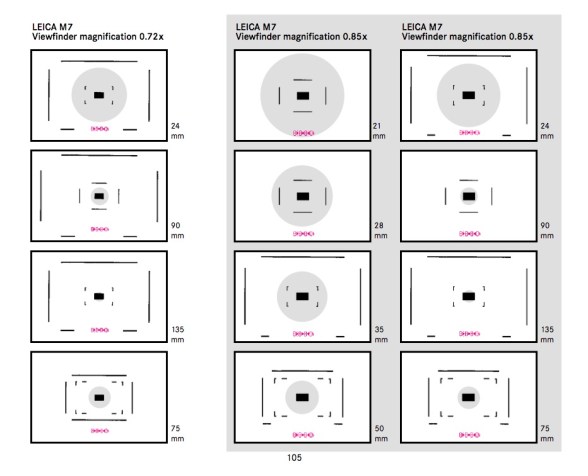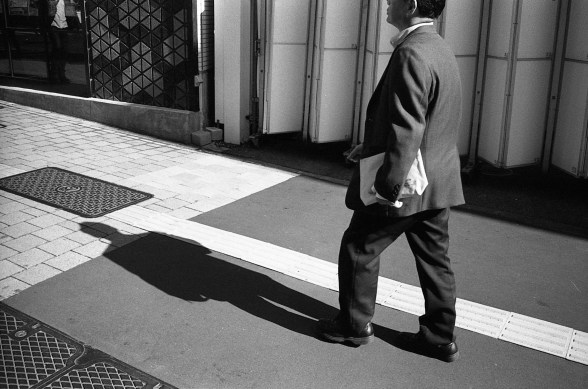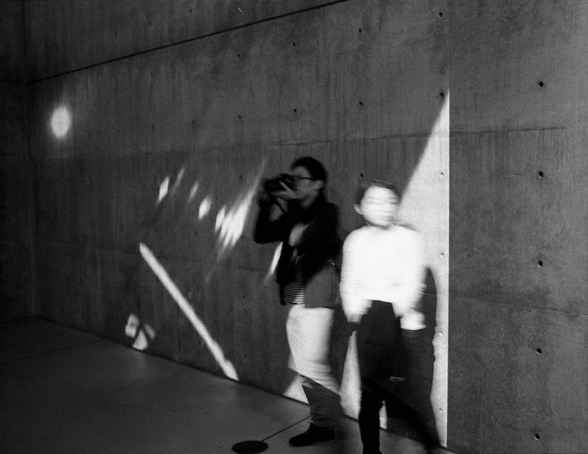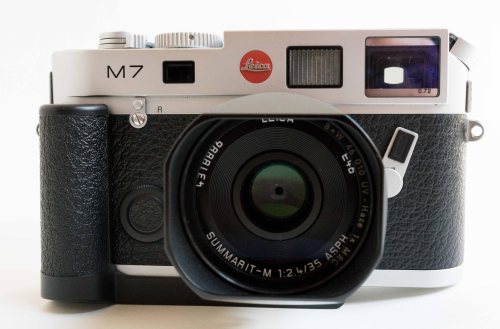The camera that legends used – Robert Capa, Henri Cartier-Bresson, Garry Winogrand… Leica Cameras are mostly an object of lust for most photographers Here are my thoughts on a second hand Leica M7 body and 35mm lens combo for street photography.
Firstly, let’s talk about the Body.
Everything is beautiful.
I understand now where Apple may have got their packaging inspiration from. When you get anything Leica, the packaging is simply stunning. It completely alters your experience of the product inside. You fall in love instantly and irrationally. I will not post a gratuitous unboxing video here, but if you are purchasing an M7 second hand, try to find one with the original packaging. You will not be disappointed.
Packaging is not the priority… but it is an indicator that something special is inside.
Every bit of the Leica M7 is designed to last a lifetime. There is no plastic, except for the iso dial on the back. Almost everything is metal. The film advance lever. The shutter control dial. The film winding knob. It is virtually bulletproof. In a world full of plastic disposability, it is such a wonderful experience to hold such a well designed camera.
Aesthetically, it is perfect. The proportions of the body are pleasing to the eye – considerably more so than the current crop of Leica Digital M bodies, which are pretty, but not as nice as the film bodies. The digital Ms just seem a little fat in the middle for me.
It might be a great looker, but the first recommendation is to get a grip. The body is a little bit slippy for my liking. A grip makes all the difference. The grip pictured is a Leica branded accessory which, of course, fits perfectly. It makes a big difference to the useability for me – particularly as I can be a clumsy at times!
Controls
The controls are laid out in a very ergonomic manner – I never seem to flail about whilst out and about. The film advance lever has a hinged black end on it, which is very easy to use. Winding on film is quick and efficient. The placement of the winder and shutter button allow for very quick shooting.
The most efficient settings for Street Photography I find are :
Set to Aperture Priority
Set Aperture to F8 for Hyperfocal Distance focusing
ISO 800 minimum (using ISO 400 film)
This will normally keep the shutter speed over 1/125 for outdoor shooting in good light conditions. The Leica M6 has a much stronger fan base than the M7 – people usually talk about wanting the whole “manual” experience. Personally, I find having to adjust both aperture and shutter speed constantly under different lighting conditions distracting at best, and often forget to check prior to taking the shot – resulting in poorly exposed images. I prefer to focus on composition, not settings.
That doesn’t mean that I don’t adjust my shutter and aperture settings manually from time to time – I just don’t want to have to worry about it on the fly when an opportunity fleets by. Most opportunities for an image only last a few seconds, I need to be able to point the camer and shoot quickly.
The M7 has a very accurate light meter to support the Aperture Priority function. This makes is a winner in my books over the M6 for street photography.

The ISO control dial can be a bit fiddly. The ISO dial and the exposure compensation dial are integrated into a single control. To adjust the ISO you have to kind of get your thumb into the raised ridges in the middle and twist it without moving the outer EC dial. I suppose it is not that big a deal, seeing as you only set the ISO once per roll. It is just awkward.
I find that ISO 800 is my preferred setting – I normally shoot ISO 400 film exclusively, so this combo ensures I normally get quick shutter speeds at F8 or so. If it is a particularly dull day, I have to switch to ISO 1000 or more. I normally do not go above ISO 1600 though. If I am already shooting at ISO 800 and need more light, I just dial down the Aperture to F2.4.
Shooting at F2.4 presents some challenges though – whilst it usually “fixes” the shutter speed, it creates two challenges. I need to manually focus and the depth of field is incredibly narrow. It becomes easy to “miss” your focus point.
Hyperfocal Distance and Why It Is Perfect for Street Photography.
Hyperfocal Distance is simply prefocusing so you can just snap your subjects instantly without any kind of focusing delay. You literally just point the camera at your subject and hit the shutter button. Rangefinders are particularly well suited to this technique. Let me explain how it works, but you will have to look up the optical theory behind it yourself, if you are interested!

It works like this :
- Select your preferred aperture – keeping in mind that the higher the aperture, the wider the focus zone will be. In the example above, the aperture is set at F11.
- On the focus ring, move the infinity symbol to the number on the right hand side that matches the aperture setting.
- Look to the same, matching aperture number on the left and read the distance mark above it. With the infinity symbol on the right above the 11, the distance marker that matches the 11 on the left looks to be a bit more than 1.5 metres but less than 2 metres. Let’s call it 1.7 metres to be sure. That is your minimum focus distance.
Everything further away than 1.7 metres from the camera is now in focus. Basically, it means that everything from 1.7 metres to infinity is now in focus. You can just shoot away without any concern over focus, providing you are more than 1.7 metres away from your subject. All you have to worry about is making sure your shutter speed is quick enough.
If you change the aperture to F8, the hyperfocal distance changes from 1.7 metres to 2 metres, letting more light into the camera. At F4 it is 5 metres minimum distance. The longer the focal length of the lens, the further away the minimum focus distance gets. Wide angle lenses are best suited to using hyperfocal distance. A 50mm lens at F11 has a minimum focus distance of around 4 metres using hyperfocal distance.
On a day with good light, setting the aperture at F8 or F11 and using hyperfocal distance, you can shoot an individual frame quicker than a $9,000 Nikon D5. Even the quickest autofocus takes time to focus. There is no lag whatsoever using hyperfocal distance.
And even the best autofocus doesn’t always pick the thing to focus on that you intend. I have plenty of digital shots where the dumb ass camera focused on the wrong thing. Even selecting the focus point takes a second or two that you may not have when shooting candidly on the street.
You can do the same with manual focus SLR lenses, but that is a discussion for another day!
The Body
Aesthetically, it is perfect. The proportions of the body are pleasing to the eye – considerably more so than the current crop of Leica Digital M bodies, which are pretty, but not as nice as the film bodies. The digital Ms just seem a little fat in the middle for me.
It might be a great looker, but the first recommendation is to get a grip. The body is a little bit slippy for my liking. A grip makes all the difference. The grip pictured is a Leica branded accessory which, of course, fits perfectly. It makes a big difference to the useability for me – particularly as I can be a clumsy at times!
The M7 also comes in an all black body. I originally thought I liked the black better, but the stainless look of the M7 I have reviewed is very pretty.
You can read more about rangefinders here.
Rangefinders are much more compact than an SLR – think the size of mirrorless cameras like the Sony A7 body vs a standard DSLR as a comparison point. Also featured is Mrs Melbourne Street Photography holding the body for a size comparison.
Above is a comparison of a Nikon D700 (with a very chunky 85mm old school lens attached!) vs the Leica M7. Rangefinders are very unobtrusive and much smaller than an SLR. People associate SLR bodies with “professionals” and tend to attract attention from the public who are prone to suspicion. Rangefinders look almost like a compact point and shoot. You can get away with a lot more shooting a rangefinder than a big ass DSLR and lens…
Viewfinder
Rangefinder lenses are much smaller for the same quality as a DSLR – this is primarily due to the lack of a mirror system for the viewfinder. The M7 comes in a range of viewfinders with various frame lines for different lenses. Go back here if you are not sure how rangefinders focus…
Before you buy an M7, think about the lens you are going to match it with. There are three different viewfinders available : 0.58, .072, and 0.85 (the number refers to the magnification factor of the viewfinder. The framelines are automatically selected by the camera and appear as per the below images through the viewfinder :


This is what they look like through the viewfinder :
 35mm is my preferred focal length for street photography, and the M7 featured is a 0.72 model. The frameline for a 35mm focal length lens is almost perfect in the viewfinder. It takes up about 75% of the available viewfinder space, making it easy to compose images, whilst still offering a view of the surrounding space outside of shot.
35mm is my preferred focal length for street photography, and the M7 featured is a 0.72 model. The frameline for a 35mm focal length lens is almost perfect in the viewfinder. It takes up about 75% of the available viewfinder space, making it easy to compose images, whilst still offering a view of the surrounding space outside of shot.
Rangefinder viewfinders are very useful in this way. A regular camera’s viewfinder is normally an exact representation of what is going to be in frame – if you can see it in the viewfinder, it will be in shot. A rangefinder shows a fair proportion of things not yet in shot – perfect for the classic street photography technique of setting up the shot and waiting for the right subject to come into frame.
You can see subjects coming into the frame rather than just “appearing” in the viewfinder once they are in shot. It is surprisingly cool, and something I rely on regularly.
The Leica viewfinder is bright and the focus spot is easy to see.
Loading Film
I still manage to stuff this up from time to time. It can be a bit of a chore at times, especially trying to do it quickly. Here is a video from Youtube of a guy loading an M6 – it has virtually the same system as the M7.
Sorry it is not me – my video skillz suck bad.
The Leica film loading technique is quirky – I much prefer a standard 35mm film loading system. I suppose it is not that big a deal. Just make sure that once you have loaded the film that you check to see the film winder is turning when you advance the film. If it ain’t turning you ain’t loaded the film correctly.
One tip is to make sure the film is fully pushed down into the body and onto the winder. Whenever I screw up the load, it is usually because I haven’t pushed the film canister right down onto the winding cog.
If you do experience an issue with a film misfeed, the Leica system continues to suck. It can be quite a task to extract the film from the body, as access is quite limited due to the design – it is hard to “get” at the film canister when there is a problem…
Loading Batteries – Another Opportunity to be Clumsy.
The batteries in the Leica last many, many rolls of film. The shutter is electronic, unlike the M6. Even with no battery, the Leica has two mechanical shutter speeds which will work regardless – 1/60 and 1/125. You will still need to meter for light though.
The batteries fit into the little round chamber on the front of the body. Make sure you buy the correct 3 volt DL 1/3 N batteries… They are only available from specialty battery places, so always have a few spares, otherwise you will be shooting manually. The batteries last nominally for about 65 rolls according to the manual.
Yah, whilst I love this camera, it is “moody”…
Summarit-M 35mm f/2.4 ASPH Lens
It seems a shame to not match a Leica body with a Leica lens. Beware though, Leica lenses are not for the faint hearted when it comes to parting with money. This M7 was paired with a bottom end 35mm Leica lens.
Just like the body, everything is perfect on the lens. The hood is metal, and the flat spots automatically end up where they are supposed to when you finish winding it on – it is perfectly engineered to fit the lens. The action on the lens is fantastic. Whilst I prefer to use hyperfocal distance when shooting, when I have to manually focus, the lens is instantly responsive without feeling “loose” or inaccurate. It moves easily without offering that bit of resistance to ensure accurate focusing.

The lens has a handy finger rest to make focusing easy. All the markings on the barrel are extremely hard wearing and easily visible. Each aperture selection clicks nicely and feels good.
Am I sure the lens delivers a better image than a affordable Voigtlander lens? Absolutely – I have shot with the Voigtlander 35mm lens and the featured Leica. Is it ten times better? Probably not. The 35mm Voigtlander lens produces some pretty good results. Is it nice using a Leica lens? Of course…
Street Photography Recommendation
The Leica M7 and 35mm lens is almost the perfect street photography camera kit.
On the plus side :
- Compact and unobtrusive
- Fantastic image quality
- Ability to use hyperfocal distance for quick shots
- Being able to see outside the frame in the view finder
- Aperture priority function
- Build quality and engineering
- Rangefinder shutters are incredibly quiet
On the not so awesome side :
- Fiddly film loading
- Fiddly battery loading
- Cost to buy (you can still buy M7 kits new at BHPhoto)
- Cost to repair / replace
Reviewing this list is a reminder that the best things about the Leica are mostly related to it being a rangefinder, rather than specifically being a Leica.
Buying Guide and Conclusions
Do you really want a Leica? Nobody really needs one. So, the investment is an emotional one. It is a beautiful camera and lens. Using this camera made me feel I was walking in the footsteps of the masters that have come before me.
It is a pleasure to hold and admire. The build quality and aesthetics are why some people (people with loads of spare cash!) collect Leicas. Leica film bodies are a reminder of a mechanical, analogue past where quality, design, and engineering mattered. Leica film bodies are designed to last forever – unlike digital bodies which are constantly being made obsolete by the latest models.

So, this is the kind of camera you want to spend your entire life with. Emotional decision… The thing I love most about using the M7 is that it is a rangefinder. If you are sensible or have limited funds, but would love to own a rangefinder, go for a second hand Voigtlander system such as the R4A with a 35mm Voigtlander lens. You should be able to find a body and lens for about $1000 Aussie.
The Voigtlander looks pretty sexy too, huh? It also takes some great images. Owning a Leica will not make you a better photographer. Only practice, study, and reviewing will make you a better photographer.
You can read about Voigtlanders here.
Owning a Leica will make you happy for a little while, then the Hedonic Treadmill will kick in. From wikipedia :
The hedonic treadmill, also known as hedonic adaptation, is the observed tendency of humans to quickly return to a relatively stable level of happiness despite major positive or negative events or life changes.
Whilst the Leica will feel special for a while, the rush of good feeling will eventually evaporate as it becomes part of your “everyday”. Even a Ferrari will feel ordinary once you have owned one for a few months. How will you feel about your purchase in six months’ time, having invested so much?
Just keep this in mind when making the decision.
Are you confident taking an expensive camera out on street photography jaunts? Are you prepared to lose it or permanently damage it? It could happen. The best camera for any situation is the one you have with you. If you will feel reluctant to take such an expensive bit of kit out of the house, don’t buy it. If you are worried about damaging it, don’t buy it. Leaving on the shelf, safe at home, is a waste of a camera.
There are no zoom lenses for rangefinders. To zoom, you have to use your feet to get closer or further away. If you have confidence issues, and prefer a longer focal length or use a zoom regularly, be careful of buying a rangefinder. Most lenses are 50mm and under in focal length, which means you have to get up close and personal with many subjects.
Conclusion
Buy one if you want one! Buy a Voigtlander if you want a rangefinder but don’t want to invest your life savings… Here are two of my favourites taken with the Leica M7…



 January 2, 2017
January 2, 2017 














Great blog! Happy new year 🎉
LikeLike